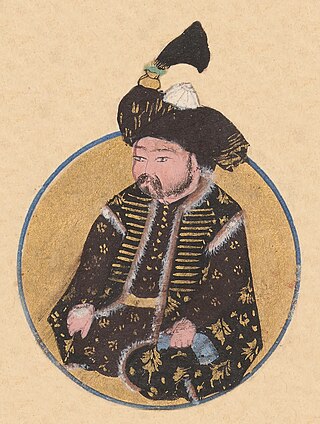Related Research Articles

Sunni Islam is the largest branch of Islam, followed by 85–90% of the world's Muslims, and simultaneously the largest religious denomination in the world. Its name comes from the word Sunnah, referring to the tradition of Muhammad. The differences between Sunni and Shia Muslims arose from a disagreement over the succession to Muhammad and subsequently acquired broader political significance, as well as theological and juridical dimensions. According to Sunni traditions, Muhammad left no successor and the participants of the Saqifah event appointed Abu Bakr as the next-in-line. This contrasts with the Shia view, which holds that Muhammad appointed his son-in-law and cousin Ali ibn Abi Talib as his successor.

The Fatimid Caliphate or Fatimid Empire was a caliphate extant from the tenth to the twelfth centuries CE under the rule of the Fatimids, an Isma'ili Shia dynasty. Spanning a large area of North Africa and West Asia, it ranged from the western Mediterranean in the west to the Red Sea in the east. The Fatimids trace their ancestry to the Islamic prophet Muhammad's daughter Fatima and her husband Ali, the first Shia imam. The Fatimids were acknowledged as the rightful imams by different Isma‘ili communities as well as by denominations in many other Muslim lands and adjacent regions. Originating during the Abbasid Caliphate, the Fatimids initially conquered Ifriqiya. They extended their rule across the Mediterranean coast and ultimately made Egypt the center of the caliphate. At its height, the caliphate included—in addition to Egypt—varying areas of the Maghreb, Sicily, the Levant, and the Hejaz.
The Fatimid dynasty was an Arab dynasty that ruled the Fatimid Caliphate, between 909 and 1171 CE. Claiming to be descended from Fatima and Ali and adhering to Isma'ili Shi'ism, they held the Isma'ili imamate and considered themselves the rightful leaders of the Muslim community. The line of Nizari Isma'ili imams, represented today by the Aga Khans, claims descent from a branch of the Fatimids. The Alavi Bohras, predominantly based in Vadodara, also claim descent from the Fatimids.

Abū Jaʿfar ʿAbd Allāh ibn Muḥammad al-Manṣūr usually known simply as by his laqab al-Manṣūr (المنصور) was the second Abbasid caliph, reigning from 136 AH to 158 AH succeeding his brother al-Saffah. He is known for founding the 'Round City' of Madinat al-Salam, which was to become the core of imperial Baghdad.

Abu al-ʿAbbās Abd Allāh ibn Muḥammad ibn ʿAlī ibn ʿAbd Allāh ibn ʿal-ʿAbbās, known by his laqab al-Saffah, was the first caliph of the Abbasid Caliphate, one of the longest and most important caliphates in Islamic history.

Abu Muslim Abd al-Rahman ibn Muslim al-Khurasani was a Persian general who led the Abbasid Revolution that toppled the Umayyad dynasty, leading to the establishment of the Abbasid Caliphate.
Ja'far ibn Muhammad al-Sadiq was a Shia Muslim scholar, jurist, and theologian, and the sixth imam of the Twelver and Isma'ili branches of Shia Islam. Known by the title al-Sadiq, Ja'far was the founder of the Ja'fari school of Islamic jurisprudence. The hadith recorded from al-Sadiq and his predecessor, Muhammad al-Baqir, are said to be more numerous than all the hadith preserved from the Islamic prophet Muhammad and the other Shia imams combined. Among other theological contributions, he elaborated the doctrine of nass and isma, as well as that of taqiya.
Isma'il ibn Ja'far was the eldest son of Ja'far al-Sadiq and the sixth Imam in Isma'ilism. He carried the epithet of al-Mubarak, on the basis of which one of the earliest Isma'ili groups became designated as the Mubarakiyya.

Abu'l-Abbas Ahmad ibn Ishaq, better known by his regnal name al-Qadir, was the Abbasid caliph in Baghdad from 991 to 1031.

The Qarmatians were a militant Isma'ili Shia movement centred in al-Qatif in Eastern Arabia, where they established a religious—and, as some scholars have claimed, proto-socialist or utopian socialist—state in 899 CE. Its members were part of a movement that adhered to a syncretic branch of Sevener Ismaili Shia Islam, and were ruled by a dynasty founded by Abu Sa'id al-Jannabi, a Persian from Jannaba in coastal Fars. They rejected the claim of Fatimid Caliph Abdallah al-Mahdi Billah to imamate and clung to their belief in the coming of the Mahdi, and they revolted against the Fatimid and Abbasid Caliphates.

Islam came to Yemen around 630 during Muhammad's lifetime and the rule of the Persian governor Badhan. Thereafter, Yemen was ruled as part of Arab-Islamic caliphates, and became a province in the Islamic empire.
The Mahdi is a figure in Islamic eschatology who is believed to appear at the End of Times to rid the world of evil and injustice. He is said to be a descendant of Muhammad, who will appear shortly before Jesus.
The Kaysanites were a Shi'i sect of Islam that formed from the followers of Al-Mukhtar. They traced Imamate from Muhammad ibn al-Hanafiyyah and his descendants. The name Kaysaniyya was most likely derived from the name of Mukhtar's chief guard, Abu Amra Kaysan.

Musa ibn Ja'far al-Kazim was a descendant of the Islamic prophet Muhammad and the seventh imam in Twelver Shia Islam. Musa is often known by the title al-Kazim, apparently a reference to his patience and gentle disposition. He was born in 745 CE in Medina to Ja'far al-Sadiq, the sixth Shia imam, who died in 765 without publicly designating a successor to save his heir from the wrath of the Abbasid caliphs. The subsequent crisis of succession was eventually resolved in favor of al-Kazim, with a dissenting group, now known as the Isma'ilis, separating from the mainstream Shia.
The Alid revolt of 762–763 or Revolt of Muhammad the Pure Soul was an uprising by the Hasanid branch of the Alids against the newly established Abbasid Caliphate. The Hasanids, led by the brothers Muhammad and Ibrahim, rejected the legitimacy of the Abbasid family's claim to power. Reacting to mounting persecution by the Abbasid regime, in 762 they launched a rebellion, with Muhammad rising in revolt at Medina in September and Ibrahim following in Basra in November.
The Battle of Fakhkh was fought on 11 June 786 between the forces of the Abbasid Caliphate and the supporters of a pro-Alid rebellion in Mecca under al-Husayn ibn Ali, a descendant of Hasan ibn Ali.
Batrīyya or Butrīyya is an early branch of Zaydī Islam.
Hamdan Qarmat ibn al-Ash'ath was the eponymous founder of the Qarmatian sect of Isma'ilism. Originally the chief Isma'ili missionary in lower Iraq, in 899 he quarreled with the movement's leadership at Salamiya after it was taken over by Sa'id ibn al-Husayn, and with his followers broke off from them. Hamdan then disappeared, but his followers continued in existence in the Syrian Desert and al-Bahrayn for several decades.
References
- ↑ Kohlberg, E. (1960–2005). "al-Rāwandiyya". The Encyclopaedia of Islam, Second Edition (12 vols.). Leiden: E. J. Brill. doi:10.1163/1573-3912_islam_SIM_6254.
- 1 2 3 Berkey, J. P. (2003). The formation of Islam: Religion and society in the Near East, 600-1800. New York: Cambridge University Press.
- 1 2 Aikin, John (1747). General biography: or, Lives, critical and historical, of the most eminent persons of all ages, countries, conditions, and professions, arranged according to alphabetical order. London: G. G. and J. Robinson. ISBN 1333072457